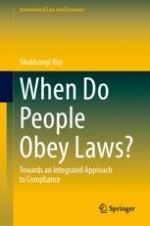2024 | OriginalPaper | Chapter
5. Understanding the Role of Procedural Justice in Compliance Through the Integrated Framework
Author : Shubhangi Roy
Published in: When Do People Obey Laws?
Publisher: Springer Nature Switzerland
Activate our intelligent search to find suitable subject content or patents.
Select sections of text to find matching patents with Artificial Intelligence. powered by
Select sections of text to find additional relevant content using AI-assisted search. powered by
